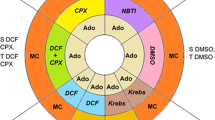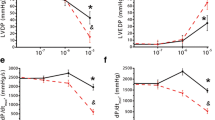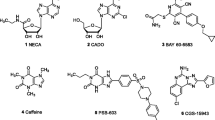Summary
Experiments employing guinea pig heart Langendorff preparations compared the coronary vasoactivity of a functionalized congener of adenosine, 2-[(2-aminoethyl-aminocarbonylethyl)phenylethylamino]-5′-N-ethylcarboxamidoadenosine, APEC, with the vasoactivity of the product of the reaction of APEC with 1,4-phenylenediisothiocyanate, 4-isothiocyanatophenylaminothiocarbonyl-APEC (DITC-APEC). Previous experiments showed that whereas APEC binds reversibly to the A2A adenosine receptor of brain striatum, DITC-APEC binds irreversibly. APEC caused concentration-dependent coronary vasodilation that persisted unchanged when agonist administration continued for up to 165 min, but promptly faded when the agent was withdrawn. The unselective adenosine receptor antagonist 8-(4-sulfophenyl)theophyline (8-SPT) antagonized the vasoactivity of APEC. By contrast, DITC-APEC1 (0.125 -1.0 nM) caused progressive, concentration-independent vasodilation that persisted unchanged for as long as 120 min after the agent was stopped and that was insensitive to antagonism by subsequently applied 8-SPT. However, perfusion of the heart with buffer containing 0.1 mM 8-SPT strongly antagonized the coronary vasodilatory action of DITC-APEC1 given subsequently. Such observations indicate that the covalent binding of DITC-APEC1 causes irreversible activation of the guinea pig coronary artery A2A adenosine receptor. Neither APEC nor DITC-APEC appeared to desensitize the coronary adenosine receptor during two or more hours of exposure to either agonist.
Similar content being viewed by others
References
Abbracchio MP, Fogliatto G, Paoletti AM, Rovati GE, Cattabeni F (1992) Prolonged in vitro exposure to rat brain slices to adenosine analogues: selective desensitization of adenosine A1 but not A2 receptor. Eur J Pharmacol 227:317–324
Belardinelli L, Linden J, Berne RM (1989) The cardiac effects of adenosine. Prog Cardiovasc Dis 32:73–97
Cornfield LJ, Hu S, Hurt SD, Sills MA (1992) [3H]2-phenylamino-adenosine ([3H]CV 1808) labels a novel adenosine receptor in rat brain. J Pharmacol Exp Ther 263:552–561
Daly JW, Butts-Lamb P, Padgett W (1983) Subclasses of adenosine receptors in the central nervous system: Interactions with caffeine and related methylxanthines. Cell Mol Neurobiol 3:69–80
Daly JW, Padgett W, Shamin MT, Butts-Lamb P, Waters J (1985) 1,3-Dialkyl-8-(p-sulophenyl)xanthines: Potent water-soluble antagonists for Al- and A2-adenosine receptors. J Med Chem 28: 487–492
Daut J, Maier-Rudolph W, von Beckerath N, Mehrke G, Günther K, Goedel-Meinen L (1990) Hypoxic dilation of coronary arteries is mediated by ATP-sensitive potassium channels. Science 247: 1341–1344
Francis JE, Webb RL, Ghai GR, Hutchison AJ, Moskal MA, deJesus R, Yokoyama R, Rovinski SL, Contardo N, Dotson R, Barclay B, Stone GA, Jarvis MF (1991) Highly selective adenosine A1 receptor agonists in a series of N-alkylated 2-aminoadenosines. J Med Chem 34:2570–2579
Hamilton HW, Taylor MD, Steffen RP, Haleen SJ, Bruns RF (1987) Correlation of adenosine receptor affinities and cardiovascular activity. Life Sci 41:2295–2302
Heller LJ, Olsson RA (1985) Inhibition of rat ventricular automaticity by adenosine. Am J Physiol 248:14907–14913
Jacobson KA, Barrington WW, Pannell LK, Jarvis MF, Ji X-D, Williams M, Hutchison AJ, Stiles GL (1989) Agonist derived molecular probes for A2 adenosine receptors. J Mol Recognition 2:170–178
Jacobson KA, Stiles GL, Ji X-D (1992) Chemical modification and irreversible inhibition of striatal A2a adenosine receptors. Mol Pharmacol 42:123–133
Kusachi S, Thompson RD, Olsson RA (1983) Ligand selectivity of dog coronary adenosine receptor resembles that of adenylate cyclase stimulatory (Ra) receptors. J Pharmacol Exp Ther 227:316–321
Lohse MJ, Klotz K-N, Schwabe U (1986) Agonist photoaffinity labeling of A1 adenosine receptors: Persistent activation reveals spare receptors. Mol Pharmacol 30:403–409
Lohse MJ, Klotz K-N, Schwabe U (1991) Mechanism of A2 adenosine receptor activation. I. Blockade of A2 adenosine receptors by photoaffinity labeling. Mol Pharmacol 39:517–523
Londos C, Cooper DMF, Wolff J (1980) Subclasses of external adenosine receptors. Proc Natl Acad Sci USA 77:2551–2554
Luty J, Hunt JA, Nobbs PK, Kelly E, Keen M, MacDermot J (1989) Expression and desensitization of A2 purinoceptors on cultured bovine aortic endothelial cells. Cardiovasc Res 23:303–307
Matsuda A, Shinozaki M, Yamaguchi T, Homma H, Nomoto R, Miyasaka T, Watanabe Y, Abiru T (1992) Nucleosides and nucleotides. 103. 2-Alkynyladenosines: A novel class of selective adenosine A2 receptor agonists with potent antihypertensive effects. J Med Chem 35:241–252
Mustafa SJ, Askar AO (1985) Evidence suggesting an Ra-type adenosine receptor in bovine coronary arteries. J Pharmacol Exp Ther 232:49–56
Nees S (1989) The adenosine hypothesis of metabolic regulation of coronary flow in the light of newly recognized properties of the coronary endothelium. Z Kardiol 78 [Suppl] 6:42–49
Nees S, Bock M, Herzog V, Becker BF, Des Rosiers C, Gerlach E (1985a) The adenine nucleotide metabolism of the coronary endothelium: Implications for the regulation of coronary flow by adenosine. In: Stefanovich N, Rudulphi K, Schubert P (eds) Adenosine receptors and modulation of cell function. Oxford, UK, IRL, pp 419–436
Nees S, Herzog V, Becker BF, Bock M, Des Rosiers C, Gerlach E (1985b) The coronary endothelium: A highly active metabolic barrier for adenosine. Basic Res Cardiol 80:515–529
Paton WDMA (1961) Theory of drug action based on the rate of drug-receptor combination. Proc R Soc Lond Biol Sci 154:21–69
Ramkumar V, Olah ME, Jacobson KA, Stiles GL (1991) Distinct pathways of desensitization of A1- and A2-adenosine receptors in DDT1 MF2 cells. Mol Pharmacol 40:639–647
Shimada J, Suzuki F, Nonaka H, Ishii A, Ichikawa S (1992) (E)-1,3-Dialkyl-7-methyl-8-(3,4,5-trimethoxystyryl)xanthines: Potent and selective adenosine A2 antagonists. J Med Chem 35: 2342–2345
Trivedi BK, Bridges AJ, Bruns RF (1990) Structure-activity relationships of adenosine A1 and A2 receptors. In: Williams M (ed) Adenosine and adenosine receptors. Clifton, NJ, Humana, pp 57–103
Ueeda M, Thompson RD, Padgett WL, Secunda S, Daly JW, Olsson RA (1991a) Cardiovascular actions of adenosines, but not adenosine receptors, differ in rat and guinea pig. Life Sci 49:1351–1358
Ueeda M, Thompson RD, Arroyo LH, Olsson RA (1991b) 2-Alkoxyadenosines: Potent and selective agonists at the coronary artery A2 adenosine receptor. J Med Chem 34:1334–1339
Watanabe H, Kuhne W, Schwartz P, Piper M (1992) A2-adenosine receptor stimulation increases macromolecule permeability of coronary endothelial cells. Am J Physiol 262:141174–141181
Watson S, Abbott A (1992) Adenosine receptors. Trends Pharmacol Sci Receptor [Suppl] 3
Wiley DM, Szabo I, Maguire MH (1991) Inhibition of [3H]CGS21680 binding to the adenosine-A2 receptor by 2-substituted adenosine analogs. FASEB J 5:A1768
Zhou QY, Li C, Olah ME, Johnson RA, Stiles GL, Civelli O (1992) Molecular cloning and characterization of an adenosine receptor: The A3 adenosine receptor. Proc Natl Acad Sci USA 89:7432–7436
Author information
Authors and Affiliations
Additional information
Correspondence to R. A. Olsson at the above address
Rights and permissions
About this article
Cite this article
Niiya, K., Jacobson, K.A., Silvia, S.K. et al. Covalent binding of a selective agonist irreversibly activates guinea pig coronary artery A2 adenosine receptors. Naunyn-Schmiedeberg's Arch Pharmacol 347, 521–526 (1993). https://doi.org/10.1007/BF00166745
Received:
Accepted:
Issue Date:
DOI: https://doi.org/10.1007/BF00166745




